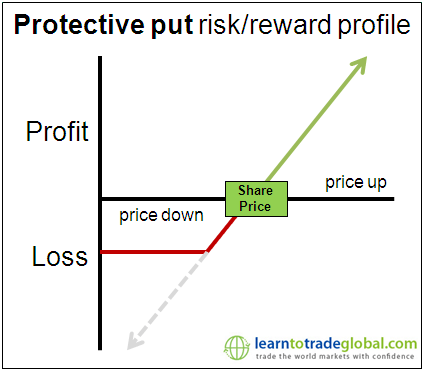Using Puts to Protect Profits and Hedge Risk
Post on: 17 Май, 2015 No Comment

Using Puts to Protect Profits
and
Hedge Risk
Introduction of Using Puts
There are many different ways to protect profits and hedge risk in a winning stock.
You can use a stop loss order, write calls options, buy put options, and more.
This article discusses the use of buying puts, and compares that to using stops.
Buying Puts
Buying puts is probably the closest alternative to using a stop loss. But it does have additional benefits and drawbacks.
First, it’s important to remember that when you buy a put option, you stand to profit as the market goes down. So in general, if someone buys a put, he or she has a bearish outlook.
But again, puts can also be used to protect profits and to hedge risk.
So how does it compare to stop loss orders?
With a stop loss order, you’re essentially putting in an order to sell a stock if it goes down to a certain price. If your stock is profitable, and you want to try and lock in a certain portion of your gains in case the market goes down, a stop loss order is a common way to do this.
Let’s say you bought 100 shares of a stock at $100 for an investment of $10,000. Each share is now worth $120 each. That’s a $20 move, or a 20% gain.
You want to stay in, just in case it goes even higher, but you’re worried about the downside as it gets ready to report earnings, for example. So you put in a stop loss order at $110. If it goes down to $110, you’re now out and you’ve locked in a $10 move or a 10% gain, which is $1,000.
The downside is that if it gaps down big, you could lose even more than you intended as that stop loss becomes a market order. In this case, you’ll get filled wherever the market allows, even below that $110 level.
Protection by Buying Puts
Buying a put can offer you protection as well. (And it can give you even better protection in the above gap down scenario.)
Using the same example of buying a stock at $100 that’s now at $120, you can instead buy a put for protection.
Let’s say you bought a $120 put with a little less than two months of time on it for $600. (This should allow enough time to go through the earnings process.)
If, at expiration, it drops to $110, your put would now be $10 in-the-money, which means it would be worth $1,000. Therefore, you made $400 on the put.
So you’re still up $1,000 of your stock buy, but you made an additional $400 on your put for a total of $1,400 on the trade. Essentially, you lost less on the pullback, which means you made more on the trade.
In theory, even if it dropped all the way to $100, which is your purchase price, you’re protected in that you’ll make the difference between your strike price and the price of the stock.
In that scenario, your stock trade would be back to $0 profit, but you’d be up $1,400 on the put option.
Drawbacks The drawback with the put though is that if the stock stayed at $120 (or in this case, above $114), you would have been better off by just using a stop, as the money you spent on the put would be lost or break-even at best.
Conclusion
So depending on the circumstance, a put might be the better choice for protection. But a stop might be better in other situations.
No strategy is perfect at all times.
But if you’re looking for downside protection, especially in a volatile stock, buying a put is usually much better than not putting in a stop. And often times, you’ll find it more opportune than a stop as well.
The key is in determining where a put makes more sense than a stop and where you’ll maximize your efforts in doing so.
Success is simple. Do what’s right, the right way, at the right time.
Take control of your future prosperity the Easy way. Become a member of Stock Options Made Easy today!
Enter your name and e-mail address below to get Stock Options Made Easy FREE newsletter. Regular updates on the latest options news delivered straight to your inbox.














